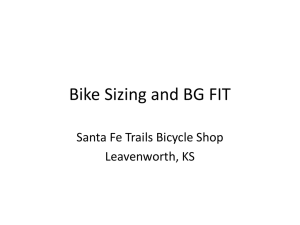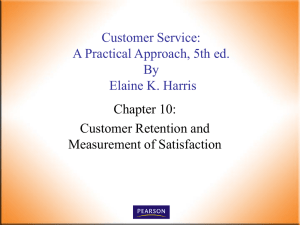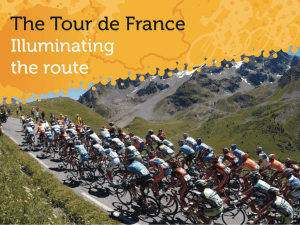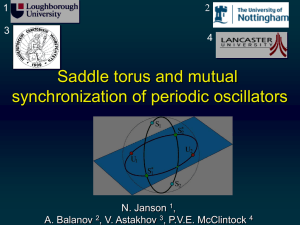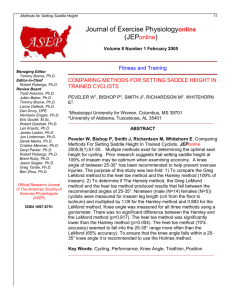Bike Fit - NJ Sports Medicine and Performance Center, Marc
advertisement
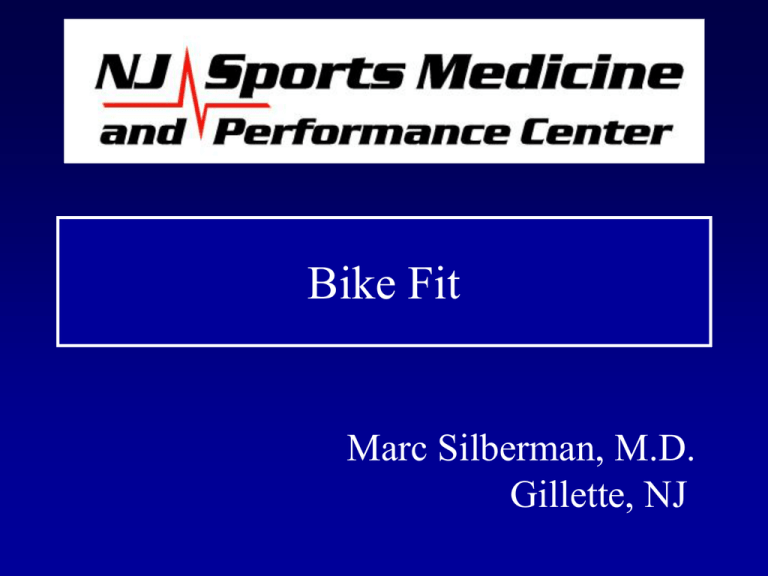
Bike Fit Marc Silberman, M.D. Gillette, NJ Supplies • • • • • • • • Bicycle trainer Stadiometer or measuring tape Text book Measuring tape Goniometer Plumb line Allen wrench set Video Camera, Tripod, Computer/TV Pro Bike Fit Fabian Cancellara, Andy Pruit, Scott Holz, Bobby Julich Bicycle Exam Balance • • • • Comfort Safety Injury Prevention Peak Performance • Aerobic efficiency versus aerodynamics Superman Position Bicycle Anatomy Seat tube Top tube Seat tube angle 72 - 74° Crankset and Chainrings Rider Height 60-64 inches 165–167.5mm 65-72 inches 170mm 39 53 72-74 inches 172.5mm 74-76 inches 175mm ER Burke Cycling Clock Diagram Myth: Clipless pedals allow the rider to pull up during steady state US National Rider 300W and 90RPM The limb is lifted but Not as fast as the pedal Is rising Broker and Gregor 1996 Order of Fit 1. Foot-Cleat-Pedal Interface 2. Pelvis-Saddle Interface Saddle Height Saddle Tilt and Fore-Aft Re-check Saddle Height 3. Hands-Handlebar Interface Height, Reach, and Tilt 2 3 1 1. Foot-Cleat-Pedal • Ball of the foot is over the pedal spindle • 1st metatarsal head 2. Saddle Height Saddle Height Most important bicycle position setting • Inseam measurement method (LeMond) – • Knee angle measurement (Pruitt, Burke) – • Saddle Height = 0.883 X inseam in cm 25 to 30 degrees knee flexion at 6 o’clock position Heel to back of pedal method – Leg almost fully extended with no hip rocking Saddle Height Lemond-Guimard Method. Saddle Height = Inseam in cm X .883 2. Saddle Height Knee flexed 25-30 degrees with pedal in 6 o’clock position. Photo by Mike Spilker. Saddle Height Fabian Cancellara and Andy Pruitt 3. Saddle Fore-Aft-Tilt Tilt Fore-Aft 3. Saddle Fore-Aft When pedal is in the 3 o’clock position, plumb line dropped from inferior pole of patella falls directly over pedal spindle. Bert Webster performing bike fit. Photos by Mike Spilker. Road vs. Time Trial Position Plumb bob falls over Steeper Seat Tube pedal spindle and 1st metatarsal More Forward Position Higher Saddle Frank Schleck TT Position Raised Goal: more power 4. Stem Height 1 to 3 inches 4. Stem Height Stem raised 1cm, rider actually became lower, more aero 4. Stem Extension Stem Size 10 –12 cm Tops Hoods Top Tube Drops 4. Stem Extension Torso flexes about 60 degrees with the hands in the drops. Torso flexes about 45 degrees with the hands on the hoods. Photo by Mike Spilker. 4. Stem Extension Andre Steensen, neck and lower back pain, shortened stem 1cm OVERUSE INJURIES Contact Overuse Neuropathy Saddle Sore Morton’s Neuroma ‘Morton’s Neuroma’ • • • • • Burning pain and numbness Impingement of interdigital nerves See riders shaking foot out of pedals Chronic inflammatory mass Between 3rd and 4th metatarsal classically ‘Morton’s Neuroma’ On the Bike Treatment • • • • Adjust cleat position, usually further back Check inside shoe for cleat bolts Change shoes to wider toe box Shoe inserts may help ‘Morton’s Neuroma’ Medical Treatment • • • • Cortisone Massage Shoe inserts Surgery Saddle Sores • • • • • • Moisture + Pressure + Friction Chafing Ulceration Folliculitis Abcess Subcutaneous nodules Saddle Sores On the Bike Treatment • • • • • • Change saddle Cut a hole in the saddle Check saddle height and tilt Clean chamois, no seams, keep dry Don’t sit around in your kit after riding Emollients Saddle Sores Medical Treatment • Prevention – Keep dry, clean, chamois, avoid shaving high • Medical Treatment – – – – – Warm soaks Topical cortisone, anti-fungal, anti-bacterial Oral antibiotics Surgical incision and drainage Surgery Hand Neuropathy • • • • • • Cyclist’s Palsy (Ulnar Neuropathy) Carpal Tunnel Syndrome Worse after long rides Worse on rough terrain EMG reversible changes May become permanent Hand Neuropathy On the Bike Treatment • • • • • • • Relieve pressure Pad bars New gloves (not gel) Reposition often Bars too far forward Too low Too much tilt Hand Neuropathy Medical Treatment • • • • Massage Cortisone Night splint Surgery Bursitis Greater Troch Pre-patella and MCL bursa Ischial Tuberosity Ischial Tuberosity ‘Bursitis’ • • • • ‘Sits Bones’ sore Cold weather, early season, time trialing Rest, Massage, Cortisone On the Bike: – Change saddle – Check saddle height and tilt – New chamois Greater Trochanteric ‘Bursitis’ • • • • • Proximal ITB Syndrome Pain with lying on side at night Physical Therapy Massage, OMT, Cortisone On the bike: – Check saddle height – Check cycling form Pre-Patellar Bursitis • • • • Aspiration and fluid analysis Cortisone RICE and massage On the bike: – – – – Check cleat and position Check saddle height and fore-aft Check pedal technique Check crank arm length MCL ‘Bursitis’ • • • • • Pain and tenderness over MCL MRI if suspicious for meniscal tear Massage Cortisone On the bike: – Check cleat – Check saddle height and fore-aft – Check pedal technique Most Common Patella Femoral ITB Patella Tendon Patella Femoral Pain Syndrome • Pain under the patella from excessive load – – – – – Hill climb Wind Big gear Time trialing Weight training Patella Femoral Pain Syndrome • • • • Tender patella facets Tender patella compression Unable to do one legged squat No effusion Patella Femoral Pain Syndrome Treatment • Off the Bike – – – – Massage Cortisone or viscosupplementation Physical Therapy Surgery for removal of medial plica • On the Bike – Check if saddle is too low or forward – Check if cranks are too long – Relative rest, supple spinning ITB Syndrome Distal • • • • • Anterolateral pain Burning or snapping Climbing, pushing big gears Wind Stationary Trainer ITB • • • • • • Massage Assisted Stretching OMT Physical Therapy Leg length evaluation Address training and bike fit • Not Rest, NSAIDs, injection, or surgery Knee Pain and Adjustment Location Cause Solution Anterior Saddle too low Saddle too far forward Cranks too long Saddle too high Saddle too far back Toes point out Feet too far apart Tight pedal tension Toes point in Feet too close Raise saddle Move saddle back Shorten cranks Lower saddle Move forward Point in Move closer Lower tension Point out Move apart Posterior Medial Lateral Arnie Baker 1998 Bicycle Medicine Strain Cervical Thoracic Lumbar Thoracic Strain/Cervical Strain • • • • • Upper trapezius Levator scapula Trigger points and spasm Do not need to be folded in half Bars too low or too far forward versus saddle to far back • Manual Therapy, Strengthening Program Trigger point injections TRAINING Training Periods of Pros 800 5% 600 15% 10% 15% % in Zone 3 > 90% HRmax km/week 400 200 0 0% 10% 80% Rest % in Zone 2 70 – 90% HRmax % in Zone 1 < 70% HRmax 90% Nov - Dec 75% Dec - Feb Pre-Season Mar - Oct Competition Training Stimulus Performance Training Volume/Intensity Overtraining • • • • • • Cyclists are notorious Clinical history is most important Many blood tests, not very helpful Exclude organic disease Profile of Mood States Performance Testing Decrement – VO2, Lactate, HR, Watts, RPE relationship Laws of Training 1. 2. 3. 4. 5. 6. 7. 8. 9. 10. The race is won in the off season Train frequently, all year round Start gradually and gently Build a big base Go hard on the hard days, easy on the easy days Do not overtrain Avoid monotony Train with others Keep a logbook Take a break at the end of a season, stay active Adapted from Tim Noakes in the Lore of Running Marc Silberman, M.D. drbicycle@njsportsmed.com
